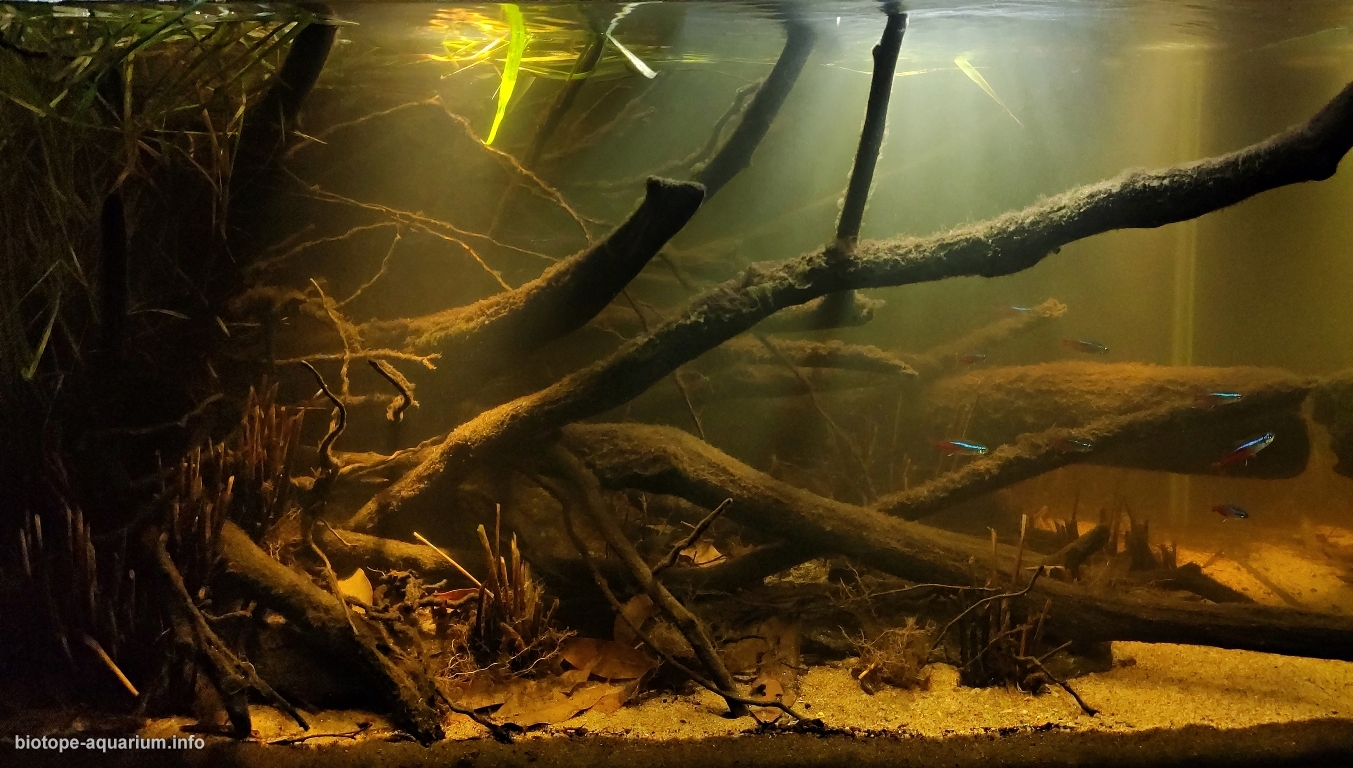Putumayo river basin in the Colombia-Perú area
_th place in Biotope Aquarium Design Contest 2020

Volume: 160 liters
Dimensions: 80x45x45 cm
List of fishes: Paracheirodon innesi, Loricaria sp., Corydoras aeneus.
List of plants: Eriochloa punctate.
Description of decorations: Alnus glutinosa branches, forest leaves, dried grass stalks, plant roots, field stones, river sand, black earth.
Description of equipment: Filtration: External filter „Eheim professionel 4+ 600“ with additional ceramic media.
Heating: Aquael Comfortzone 150W Gold line.
Lighting: Aquqel retrofit marine 10W led tube, 10W RGB led tube, 2x10W warm white led spotlights.
Water parameters: Water temperature is 24-26°C, GH – 6, pH – 6,5.
Additional info: The aquarium was started two years ago.
The water is constantly “painted” with Alnus glutinosa cones, black earth and clay mass.
About 20% of the water is changed to RO every week.
INFORMATION ABOUT BIOTOPE:
Description of the area surrounding the biotope: The Putumayo River is a classic “border river” separating Colombia from Peru at some points and from Ecuador at others.
Putumayo River, Spanish Río Putumayo, tributary, 1,000 miles (1,609 km) long, of the Amazon River (South America). It originates as the Guamués River, which flows from La Cocha Lake, high in the Andes near Pasto, Colombia. The Guamués flows southeastward into densely forested plains past Puerto Asís, Colombia, after which point it is known as the Putumayo.
The river continues its south-easterly course through tropical rain forest, forming most of the border between Colombia and Ecuador and Colombia and Peru. At Santa Clara, Colombia, it enters Brazil, where it is known as the Içá. The river joins the Amazon at Santo Antônio do Içá, Brazil.
The Putumayo is a major transportation artery, navigable for almost its total length. On its banks are numerous small river ports, and rubber is gathered from forests along its course.
Description of the underwater landscape of the biotope: Because it is a forest river and the banks are washed away by floods, it is full of fallen trees, leaves… The river substrate consists of a mixture of bright sand, white clay and mud, resulting in the water being “white coffee” in color.
Description of the parameters of the habitat: The basin in its upper section is supported by the Andean System. For this reason its average electric conductivity is of 77 S.cm-1 and a pH of 6.0. After that the Amazonian tributaries dilute the water. In the lower part of the tributaries in Tarapacá (Colombia), Huapapa (Perú) and Ipiranga (Brazil) the conductivity varies between 15 and 22 mS.cm-1, pH of 5.9, 7.2, 3.8 mg.l-1 total phosphorous, 184 mg.l-1 total nitrogenous and chlorophyll-at 1,58 mg.l-1. In this same area the difference between the river levels in high water (April-July) and low water (August-October) is 5.0 m with an average water level of 6600 m3.s-1.
The average temperature is 16-20°C, in the summer it is up to +26°C.
List of fishes and invertebrates occurring in the nature biotope: Species described in the literature:
The families with the greatest number of species are: Characidae with 86 %, Cichlidae 27 %, Pimelodidae 24 %, Anostomidae and Loricariidae with 16 % each, and Curimatidae with 15 %. These families correspond to 62% of the fishes species in River Putumayo (Colombia-Perú area).
The other 38% are from: Callichthyidae, Doradidae, Lebiasinidae, Auchenipteridae, Gasteropelecidae, Acestrorhynchidae, Sternopygidae, Potamotrygonidae, Heptapteridae, Hemiodontidae, Crenuchidae, Trichomycteridae, Pristigasteridae, Gymnotidae, Erythrinidae, Cynodontidae, Demás families.
Species found in Heiko Bleher’s expedition:
Paracheirodon innesi, Corydoras sp., Hemiodontichthys acipenserinus, Ochmacanthus aff. pedanopterus, Aphyocharax sp., Colomesus asellus, Doras sp., Pimelodella sp., Amblydoras sp., Chalceus sp., Acanthodoras sp., Hypoptopoma sp., Otocinclus sp., Gymnorhamphichthys sp., Satanoperca sp., Myoglanis sp., Tetragonopterus sp., Moenkhausia sp., Pinirampus pirinampus, Pseudoplatystoma sp., Cichla sp., Characidium etheostoma, Hyphessobrycon sp., Crenuchus sp., Leporinus sp., Elachocharax cf. pulcher, Nannostomus sp., Curimatopsis sp., Apistogramma sp., Eigenmannia cf. virescens, Crenicichla sp., Loricaria sp., Sturiosoma sp., Biotodoma sp., Mesonauta insignis, Hoplias sp.
List of plants found in the nature biotope: Eriochloa punctata, Panicum repens, Tonina fluviatilis Aubl., Aciotis purpurascens, Caperonia palustris, Eichhornia crassipes, Limnobium laevigatum, Echinodorus amazonicus.
Threats to the ecology:
Sources of information:
1. http://www.scielo.org.co/pdf/
2. https://www.alice.cnptia.
3. https://www.researchgate.net/
4. https://www.youtube.com/watch?
